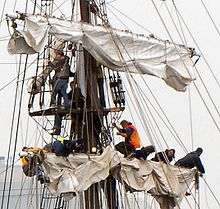Regular crew
The term crew or permanent crew (also briefly strain ) is used on ships where, although a larger crew on board, from but only a part - the crew - with the ship or ship handling is closely familiar. The rest of the crew also lend a hand, but usually do not have to bring any or hardly any prior knowledge and / or are trained on the ship. Such a subdivision is common on sailing training ships or other larger sailing training ships , especially those on which paying guests participate in or are trained in on-board operations. Crew members who do not belong to the regular crew are designated differently depending on the ship and operator, e.g. B. as "fellow sailors", "trainees", "cadets" etc.
The name was initially used primarily for sailing training ships (especially the Navy). With the emergence of organizations that teach private people how to sail traditionally on tall ships ("sail training"), the name was also extended to these ships. It is also used for expedition ships and is now sometimes used analogously for regular and long-term working groups (“crews”) on land, e.g. B. from police stations.
Regular crew on training ships

Depending on the type of operator, the regular crew drives on a voluntary basis, for a contribution towards expenses or even for a salary. The rest of the crew is usually paid significantly less or not at all (on sailing training ships of the navy and merchant navy ) or (on sailing training ships of clubs or similar) pays for the trip themselves.
The division into regular and non-regular crew is usually accompanied by a hierarchical structure: The regular crew, who usually understand more about the ship and its handling, take the responsible positions (e.g. captain , helmsman , machinist , possibly a guard , boatswain , etc.). The term “regular crew” is not primarily meant hierarchically, but describes the different roles on board, e.g. B. Members of the regular crew as trainers of the non-regular crew and / or as more experienced, as representatives of the ship, etc.
From ship to ship or operator to operator, there are major differences in the size of the regular crew. More crew members with previous experience are generally necessary for ships whose rigging and handling are more complex or require more supervision. Square sailors usually drive with a significantly larger regular crew, as they have to be regularly climbed into the shrouds ; Since climbing nowadays is usually voluntary, an experienced crew free of giddiness is carried along. B. can still work in the rig even in strong winds and rough seas. In addition, (larger) square sailors usually have a larger number of sails per mast than gaff sailors, which is also more labor-intensive. For example, take the square rigger Roald Amundsen about 17 (of 48) crew members as the root, while the gaff rigged ships of Clipper DJS that are running not climbed for ship operation in the yards need and the result per vessel usually less sailing , about 6 to 8 (from 29 to 36) men drive as a permanent crew.